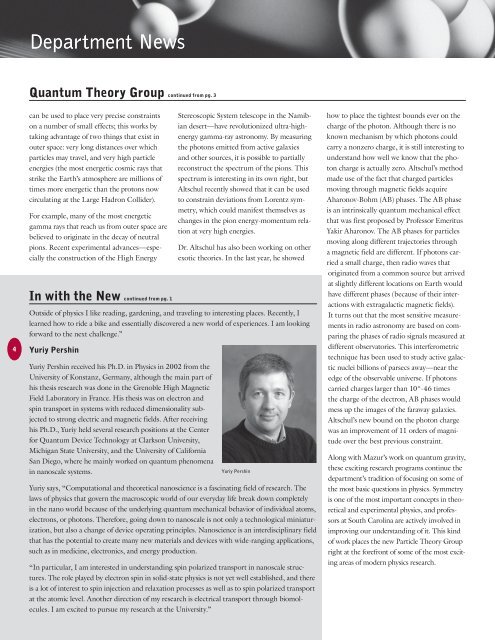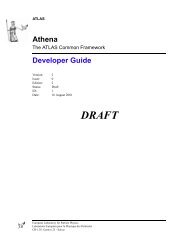In with the New - USC Department of Physics & Astronomy ...
In with the New - USC Department of Physics & Astronomy ...
In with the New - USC Department of Physics & Astronomy ...
You also want an ePaper? Increase the reach of your titles
YUMPU automatically turns print PDFs into web optimized ePapers that Google loves.
<strong>Department</strong> <strong>New</strong>s<br />
4<br />
Quantum Theory Group continued from pg. 3<br />
can be used to place very precise constraints<br />
on a number <strong>of</strong> small effects; this works by<br />
taking advantage <strong>of</strong> two things that exist in<br />
outer space: very long distances over which<br />
particles may travel, and very high particle<br />
energies (<strong>the</strong> most energetic cosmic rays that<br />
strike <strong>the</strong> Earth’s atmosphere are millions <strong>of</strong><br />
times more energetic than <strong>the</strong> protons now<br />
circulating at <strong>the</strong> Large Hadron Collider).<br />
For example, many <strong>of</strong> <strong>the</strong> most energetic<br />
gamma rays that reach us from outer space are<br />
believed to originate in <strong>the</strong> decay <strong>of</strong> neutral<br />
pions. Recent experimental advances—especially<br />
<strong>the</strong> construction <strong>of</strong> <strong>the</strong> High Energy<br />
<strong>In</strong> <strong>with</strong> <strong>the</strong> <strong>New</strong> continued from pg. 1<br />
Stereoscopic System telescope in <strong>the</strong> Namibian<br />
desert—have revolutionized ultra-highenergy<br />
gamma-ray astronomy. By measuring<br />
<strong>the</strong> photons emitted from active galaxies<br />
and o<strong>the</strong>r sources, it is possible to partially<br />
reconstruct <strong>the</strong> spectrum <strong>of</strong> <strong>the</strong> pions. This<br />
spectrum is interesting in its own right, but<br />
Altschul recently showed that it can be used<br />
to constrain deviations from Lorentz symmetry,<br />
which could manifest <strong>the</strong>mselves as<br />
changes in <strong>the</strong> pion energy-momentum relation<br />
at very high energies.<br />
Dr. Altschul has also been working on o<strong>the</strong>r<br />
exotic <strong>the</strong>ories. <strong>In</strong> <strong>the</strong> last year, he showed<br />
Outside <strong>of</strong> physics I like reading, gardening, and traveling to interesting places. Recently, I<br />
learned how to ride a bike and essentially discovered a new world <strong>of</strong> experiences. I am looking<br />
forward to <strong>the</strong> next challenge.”<br />
Yuriy Pershin<br />
Yuriy Pershin received his Ph.D. in <strong>Physics</strong> in 2002 from <strong>the</strong><br />
University <strong>of</strong> Konstanz, Germany, although <strong>the</strong> main part <strong>of</strong><br />
his <strong>the</strong>sis research was done in <strong>the</strong> Grenoble High Magnetic<br />
Field Laboratory in France. His <strong>the</strong>sis was on electron and<br />
spin transport in systems <strong>with</strong> reduced dimensionality subjected<br />
to strong electric and magnetic fields. After receiving<br />
his Ph.D., Yuriy held several research positions at <strong>the</strong> Center<br />
for Quantum Device Technology at Clarkson University,<br />
Michigan State University, and <strong>the</strong> University <strong>of</strong> California<br />
San Diego, where he mainly worked on quantum phenomena<br />
in nanoscale systems.<br />
Yuriy Pershin<br />
Yuriy says, “Computational and <strong>the</strong>oretical nanoscience is a fascinating field <strong>of</strong> research. The<br />
laws <strong>of</strong> physics that govern <strong>the</strong> macroscopic world <strong>of</strong> our everyday life break down completely<br />
in <strong>the</strong> nano world because <strong>of</strong> <strong>the</strong> underlying quantum mechanical behavior <strong>of</strong> individual atoms,<br />
electrons, or photons. Therefore, going down to nanoscale is not only a technological miniaturization,<br />
but also a change <strong>of</strong> device operating principles. Nanoscience is an interdisciplinary field<br />
that has <strong>the</strong> potential to create many new materials and devices <strong>with</strong> wide-ranging applications,<br />
such as in medicine, electronics, and energy production.<br />
“<strong>In</strong> particular, I am interested in understanding spin polarized transport in nanoscale structures.<br />
The role played by electron spin in solid-state physics is not yet well established, and <strong>the</strong>re<br />
is a lot <strong>of</strong> interest to spin injection and relaxation processes as well as to spin polarized transport<br />
at <strong>the</strong> atomic level. Ano<strong>the</strong>r direction <strong>of</strong> my research is electrical transport through biomolecules.<br />
I am excited to pursue my research at <strong>the</strong> University.”<br />
how to place <strong>the</strong> tightest bounds ever on <strong>the</strong><br />
charge <strong>of</strong> <strong>the</strong> photon. Although <strong>the</strong>re is no<br />
known mechanism by which photons could<br />
carry a nonzero charge, it is still interesting to<br />
understand how well we know that <strong>the</strong> photon<br />
charge is actually zero. Altschul’s method<br />
made use <strong>of</strong> <strong>the</strong> fact that charged particles<br />
moving through magnetic fields acquire<br />
Aharonov-Bohm (AB) phases. The AB phase<br />
is an intrinsically quantum mechanical effect<br />
that was first proposed by Pr<strong>of</strong>essor Emeritus<br />
Yakir Aharonov. The AB phases for particles<br />
moving along different trajectories through<br />
a magnetic field are different. If photons carried<br />
a small charge, <strong>the</strong>n radio waves that<br />
originated from a common source but arrived<br />
at slightly different locations on Earth would<br />
have different phases (because <strong>of</strong> <strong>the</strong>ir interactions<br />
<strong>with</strong> extragalactic magnetic fields).<br />
It turns out that <strong>the</strong> most sensitive measurements<br />
in radio astronomy are based on comparing<br />
<strong>the</strong> phases <strong>of</strong> radio signals measured at<br />
different observatories. This interferometric<br />
technique has been used to study active galactic<br />
nuclei billions <strong>of</strong> parsecs away—near <strong>the</strong><br />
edge <strong>of</strong> <strong>the</strong> observable universe. If photons<br />
carried charges larger than 10^-46 times<br />
<strong>the</strong> charge <strong>of</strong> <strong>the</strong> electron, AB phases would<br />
mess up <strong>the</strong> images <strong>of</strong> <strong>the</strong> faraway galaxies.<br />
Altschul’s new bound on <strong>the</strong> photon charge<br />
was an improvement <strong>of</strong> 11 orders <strong>of</strong> magnitude<br />
over <strong>the</strong> best previous constraint.<br />
Along <strong>with</strong> Mazur’s work on quantum gravity,<br />
<strong>the</strong>se exciting research programs continue <strong>the</strong><br />
department’s tradition <strong>of</strong> focusing on some <strong>of</strong><br />
<strong>the</strong> most basic questions in physics. Symmetry<br />
is one <strong>of</strong> <strong>the</strong> most important concepts in <strong>the</strong>oretical<br />
and experimental physics, and pr<strong>of</strong>essors<br />
at South Carolina are actively involved in<br />
improving our understanding <strong>of</strong> it. This kind<br />
<strong>of</strong> work places <strong>the</strong> new Particle Theory Group<br />
right at <strong>the</strong> forefront <strong>of</strong> some <strong>of</strong> <strong>the</strong> most exciting<br />
areas <strong>of</strong> modern physics research.

















